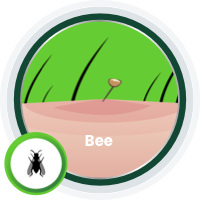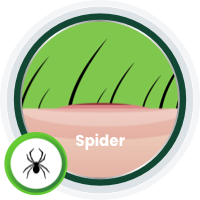If you and your family love spending time outdoors, then chances are you have had your fair share of dealing with pesky insects, who pack more sting in their bite than their size presumably permits. A bite from insects such as an ant or mosquito is easily treatable on your own. However, it can cause adverse reactions in children. Therefore, it is important for you to be able to identify and differentiate between the different type of bug bites as it will help your doctor to determine if you or your child is experiencing any possible adverse reactions, and treat them accordingly.
“Bug bite” is an all-encompassing term for bites and stings that come from arthropods. A bite or sting that comes from insects (bees, mosquitoes, wasps and fire ants) or arachnids (spiders, mites and ticks) tend to affect us humans the most(1). Below listed are the common symptoms and treatment methods for each individual insect bite.

Mosquito Bites
Out of all the insect bites suffered by humans, a mosquito bite is the most common of them all. They are hard to detect at first because you will not be able to feel anything until after a mosquito has finished biting you. But once their saliva sets into your skin, you’ll notice, at the very least, a small red bump where the mosquito's mouth (also known as proboscis) has penetrated your skin. The area of skin where a mosquito has bitten will turn itchy for a duration of up to 24 hours before returning back to normal (that is, if you’re not allergic to mosquito bites).
For the most part, a mosquito may only result in mild irritation. But sometimes, it can be a cause for concern as some mosquitoes can also carry diseases. These mosquitoes carry the viruses responsible for diseases such as malaria and dengue, amongst other. If your child develops a fever and headaches, or is feeling under the weather after being bitten by a mosquito, see a doctor immediately.

Ant Bite
Ant bites are generally harmless, especially if they come from garden ants. The type of ant bites that you should actually be concerned about are fire ant bites. This is because their stingers can both inflict pain and inject venom, causing a number of adverse reactions amongst children. The area of skin where a fire ant has bitten a child will most likely experience a sterile pustule and burning sensation within 24 hours. There may also be the occurrence of a rash around the pustule, which can be itchy and painful. Paracetamol and ibuprofen can help to ease the pain, but do seek consultation with a healthcare professional if the bite symptoms continue to persist.
It is also important to note that the venom in a fire ant's bite can also cause anaphylaxis, which is typically recognized through symptoms such as flushed skin, difficulty breathing, body weakness and dizziness. If you notice your children experiencing any of these symptoms, take them to the hospital immediately as they are considered as dangerous reactions (2).

Bee, Wasp and Hornet Stings
A sting from any of these three insects will look identical to each other because all three of them use stingers to attack. The only difference is that a bee can only attack you once, which causes their stinger to separate from their body and get left behind on your skin, whereas wasps and hornets can attack you repeatedly. The area of skin where a bee, wasp or hornet has stung will most likely experience a painful swelling, and nothing else.
Children, however, can experience an allergic reaction to being stung. Usually, the allergic reaction will manifest itself as a swelling on, and around, the area of skin which has been stung. But in more severe cases, the venom of a sting can cause anaphylaxis, which can be life-threatening. The symptoms of anaphylaxis include a rapid pulse, difficulty breathing, itching and swelling on different parts of your body, dizziness, body weakness and stomach cramps.
To treat a sting, gently remove the stinger or the insect from the skin (if it is still there). Avoid squeezing to prevent the injection of more venom into your skin. If you do notice any signs of anaphylactic shock in your children, take them to a hospital's emergency room immediately(3).

Spider Bites
Spider bites are typically harmless. However, some spider bites may also contain venom which, if left untreated, can cause fatality.
A spider bite usually starts out painless, but can eventually turn into an inflamed, painful lesion. The bites from poisonous spiders can also the affected area to turn red, white or blue in a matter of just a few days. A bite from a black widow spider, alternatively, is not characterised by these same symptoms, but by symptoms which include muscle cramping and neuromuscular-related problems(4). To prevent the symptoms of a venomous spider bite from worsening, they must be controlled, and immediate medical attention must be provided.
These are some of the most common insect bites you will encounter in your daily life. As such, it is important for you to be able to differentiate the symptoms of each bite, so as to treat them effectively. And before you choose to spend time outdoors, it is advisable for you to do some basic research on what type of insects to expect at the location you're headig to, and to bring both oral and topical treatments with you as a precautionary measure.
References:
- Powers, Jim and Rachel H. McDowell. “Insect Bites.” StatPearls [Internet]. From the National Center for Biotechnology Information, US National Library of Medicine. Accessed 02 September 2020. https://www.ncbi.nlm.nih.gov/books/NBK537235/.
https://myhealth.alberta.ca/health/pages/conditions.aspx?hwid=sig44526&lang=en-ca#sig44526-sec - Kruse, Brian, Jackie Anderson and Leslie V. Simon. “Fire Ant Bites.” StatPearls [Internet]. Fro the National Center for Biotechnology Information, US National Library of Medicine. Accessed 02 September 2020. https://www.ncbi.nlm.nih.gov/books/NBK470576/
- Insect Sting Allergy—The Facts.” Anaphylaxis Campaign. Accessed 03 September 2020. https://www.anaphylaxis.org.uk/wp-content/uploads/2019/07/Insect-Stings-2018
- Wlson, D.C. and L.E. King Jr. “Spiders and spider bites.” PubMed.gov – National Library of Medicine. Accessed 03 September 2020. https://pubmed.ncbi.nlm.nih.gov/2191800/



